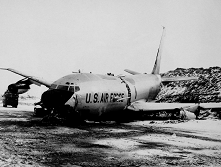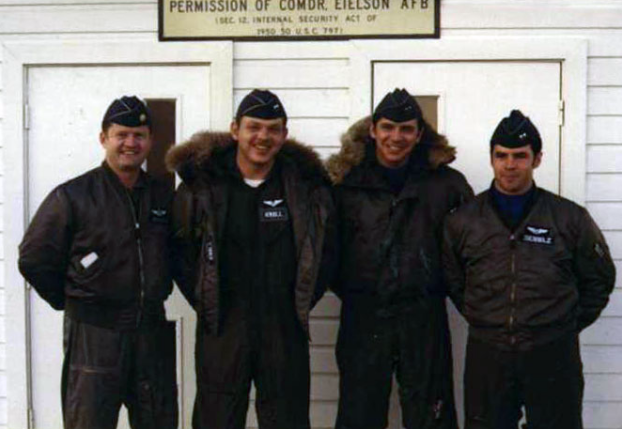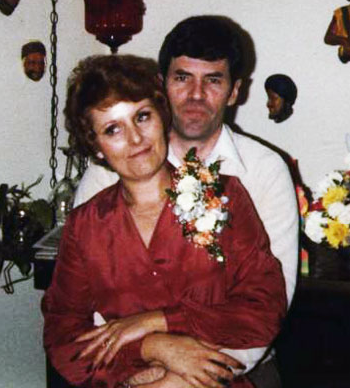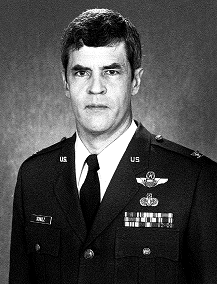
Usto's History
Summary :
 Over 40 years USAF and contractor experience in flight operations, operational intelligence activities; space and information operations activities, and, applying advanced technology to problems facing the USG, DoD, Services and Agencies coupled with extraordinary security access have produced a unique perspective on the challenges facing the US today. I have been a planner, operator, systems engineering manager and “people builder” with intimate knowledge of the space superiority mission area while intimately and directly involved with numerous Joint, Army, Navy, AF, and IC special programs for over 26 years.
Over 40 years USAF and contractor experience in flight operations, operational intelligence activities; space and information operations activities, and, applying advanced technology to problems facing the USG, DoD, Services and Agencies coupled with extraordinary security access have produced a unique perspective on the challenges facing the US today. I have been a planner, operator, systems engineering manager and “people builder” with intimate knowledge of the space superiority mission area while intimately and directly involved with numerous Joint, Army, Navy, AF, and IC special programs for over 26 years.
This is my story…
When my parents were divorced, my younger siblings and I were sent from Alaska to San Antonio TX where we grew up in a blue collar family, raised by German grandparents. After my sophomore year, my father called and asked if I wanted to move to Alaska. I said yes, if they have paved roads, so off I went. It was summer, 1958, I was 15, and Alaska was about to become a State. The start of my senior year, the old man and I had a serious talk. If I wanted to go to college, I had better figure it out, as he wasn't going to pay. I was lucky. A counselor literally nagged me to apply for this new Academy—the US Air Force Academy. Luck and a higher power were with me, and I was selected as my Congressman's principal nominee. My objectives for time at USAFA were simple: a college degree, avoid the draft, and get to pilot training—Mission accomplished. The Academy experience began an odyssey that continues to this day.One of my first lessons was to not believe everything I heard. Sitting in the auditorium that morning as guys were standing up all around me—Class Presidents, Student Council leaders, and many other accolades, I got to stand up only when they mentioned Varsity Letters, having lettered my senior year in Alaska—otherwise I'd have just sat there. I knew then that all that stuff about being wonderful didn't include me, so I spent four years following my nose.
The summer field trip after Doolie year was an eye opener. I really got to know some classmates and build relationships; also earned Jump Wings at Ft Benning. The Northern European field trip and Third Lieutenant in Europe was another memorable experience. Seeing the world—especially East Berlin just after the Wall went up, meeting new peoples, seeing new places, developing some friendships with classmates that endure even today, and just learning so much that served me well throughout my career. As we were checking out of the hotel in Upsala Sweden, I asked the got the desk girls to come out and take pictures with me—started something as other jumped on that idea. Early in Second Class year, a squadron firstie offered to sell me his car, a 1956 Ford convertible. After some serious thought, of about 10 sec, we shook hands and I had a car. I dubbed it the Beastwad. We had loads of fun with it for two years, after which I simply abandoned it, as it was in need of much repair. And so it went, I got thru USAFA somewhere in the middle of the class.
Right after graduation, I went back to AK to visit parents in Anchorage. A high school classmate had graduated from CSU, so my brother who come to my graduation, and I drove a rental car to Ft Collins and rendezvoused with my pal and together we drove the AlCan Hwy in his car. Recall that Easter Sunday in Apr 1964, the magnitude 8.4 Richter scale earthquake centered near Anchorage done a lot of damage, but fortunately very few casualties for such a powerful quake. My father and some friends were at Turnagin Arm, the section of land that shortly shortly after the quake started, literally broke off and fell into the inlet. The just barely escaped unharmed. So in Jun, as we drove into town we were stunned by the changes wrought by the quake.
Then with nothing better to do awaiting my orders for UPT, I spent a couple months working for Bob Reeve and Reeve Aleutian Airways at Cold Bay Cold Bay AK on the tip of the Alaska Peninsula. The runway was built during WWII as staging base for USAAC planes dealing with Japanese forces that had occupied Kiska and Attu further out the chain. It was a fascinating experience, a great time, and Reeve let me travel the Reeve system to see the islands—I handled actual ordinance laying in the open at Dutch Harbor left over from Japanese attacks (when told it was likely “live” I immediately put it gently where I found it).
Then it was off to pilot training at Craig AFB in Selma AL, where I got wings and went on to KC135 tankers. It was at Craig that I met my first wife, Barbara (Bobbie). My first assignment was Travis AFB in the Bay Area where I spent 18 months. The highlight of that stretch came in Apr 67 when the Doolittle Raiders came to Travis. My Sqd Commander gave me one of the two seats at the luncheon allocated to the 916th ARS. Doolittle walked up and down the tables shaking hands and introducing himself. Iwas so rattled shaking his hand I stumbled over my name! Afterwards the crowd was admonished not to come forward as the General had to go. I disobeyed and shot to the head table where my Wing Commander wanted to know “what the hell do you want, Schulz?” whereupon I shoved the menu in front and said your autograph, and then asked the General for his. So now I have a priceless memento signed by Col Dick Hoban, and Jimmy Doolittle. No one else came forward.
So I cut my teeth in SAC in the mid-60s, mostly sitting alert and occasionally flying KC-135 tankers. I had always thought I would be mostly flying and saving the nation and democracy—thoughts born in USAFA dorm talk and honed in UPT “hangar talk” with squadronmates. Life in SAC was governed by the rigidity of compliance in every aspect of SAC life—rigidity under which I chafed every day, but in later life I came to understand as absolutely essential with respect to nuclear weapons.My real career (in my view) began after being selected to fly RC-135s and “spy” on the commies. Flying around out there where mother SAC had little real control over our activities fit nicely with my instinctive out of the box approach to life, but with laser focus on “The MISSION” of flying and spying on the bad guys—a culture all us “recon guys” shared in spades. The “box” just didn't seem to apply to us doing our recon thing given all the variables of collecting what didn't want to be collected, like the latest Soviet ICBMs and SLBMs impacting Kamchatka or elsewhere in the Broad Ocean Area.
 During that time I logged over 200 operational Missions, with Soviet fighters routinely flying formation with us. Highly classified then, I can now say I flew all around the USSR, China, and N Korea collecting some great intell. On one memorable trip to Shemya in May 68, we redeployed to Johnston Island in the south Pacific where we collected unique data on the Soviet orbital bombardment system. Jan 69, returning to Shemya in our one-of-a-kind RC-135S dubbed “Rivet Ball” after midnight, the winds (per normal) were horrendous, but even worse, on short final, a blinding snowstorm dumped over 4 inches of snow on the propanol covered runway turning to instant slush. We hydroplaned 8000 ft and departed the runway over a 33 ft cliff—breaking the plane, but suffering only minor injuries due to the skill of pilot Maj John Achor. [Google A Tale of Two Planes by King Hall for the complete story.]
During that time I logged over 200 operational Missions, with Soviet fighters routinely flying formation with us. Highly classified then, I can now say I flew all around the USSR, China, and N Korea collecting some great intell. On one memorable trip to Shemya in May 68, we redeployed to Johnston Island in the south Pacific where we collected unique data on the Soviet orbital bombardment system. Jan 69, returning to Shemya in our one-of-a-kind RC-135S dubbed “Rivet Ball” after midnight, the winds (per normal) were horrendous, but even worse, on short final, a blinding snowstorm dumped over 4 inches of snow on the propanol covered runway turning to instant slush. We hydroplaned 8000 ft and departed the runway over a 33 ft cliff—breaking the plane, but suffering only minor injuries due to the skill of pilot Maj John Achor. [Google A Tale of Two Planes by King Hall for the complete story.]
In Jun of that year our sister ship, “Rivet Amber” was lost with all hands returning from Shemya to Eielson. The crew flew 5 straight days, 12 hrs / mission, over 50% approximately 200 ft over the Bering Sea searching for signs of the aircraft and crew. Cloud bases were approximately 500 ft. Those were the saddest missions I flew, as nary a trace was found to this day. In Oct 70, I was upgraded to crew commander, at the time, the only “slick wing” recon crew commander in SAC.

Usto's Crew, 1971, Eielson
I had my heart set on flying the SR-71. My Vice Wing Commander suggested I apply for U-2s as a stepping stone, which I did. In Dec 71 I was invited to Tucson for an interview and was selected, reporting in Jan 72 for training. On my seventh ride, I had a bad day and pranged the bird, shearing the gear and catching fire. Since I was still in training, the crash equipment was there and kept things from getting out of control. Thus ended my budding U-2 career before I even got to altitude. With my dream up in smoke, I decided to move on beyond the cockpit and applied for AFIT.There was a short detour to SEA just as things were winding down there. My tour at Korat lasted 6mos, and was curtailed. Since I was way early, I asked to return to Tucson and attend the University of Arizona for my AFIT tour, and that was approved. Returning to Tucson in Nov to await class in Jan, I hung out with my U-2 buds, who told me that after my accident they held up the next two students pending refurbishment of the damaged airframe into a two-seat trainer dubbed U-2CT. They assured me that my accident had the beneficial effect of likely saving two lives, as the two holdups began in the two-seater, but could not land the bird safely, and ultimately washed out. The consensus was they would have been injured or killed in the single seater.
I finished grad school with an MSEE and reported to HQ SAC for duty as a Satellite Communications Engineer, a relatively new field in 1976 and quite unique in the Command at that time. National level policy changes in the late 70s were changing nuclear war planning from 30-minutes and good night Irene, to 6-MONTH protracted war planning. The problem was how to command and control (C2) the forces in such an environment. That job began a journey that has not yet ended for me. As the single SATCOM guy in SAC communications back then, there was much to learn and much more to do. So I got started munching the elephant. Tasked first to determine Soviet capabilities to disrupt our C2, I completed a detailed analysis of Soviet capabilities which led to nominating targets for nuclear targeting—six of eight nominated were approved. Next, we needed to convince the Space and Missile Systems Organization, SAMSO, that the survivable space systems they were contemplating were inadequate for SAC needs. That led to a long term relationship with then Col Bernard “Randy” Randolph, Program Director of the Air Force Satellite Communications System.
But first it was back to the cockpit for 19 months of gate time which precipitated irreconcilable differences and I filed for divorce. While getting re-qualified in the RC-135, I met my future and current wife. The time was spent at Offutt AFB with numerous TDYs. Upon completion, I was assigned to the Defense Communcations Agency, where BG Randolph hired me to be Program Element Monitor for the high priority, Joint Service Milstar satellite communications system developed to survive and endure in a nuclear holocaust. It was that Program experience that involved me in many critically important strategic matters, working with the OJCS, Army, Navy, Marines, AF, OSD as well as the NSA, NRO (highly classified then) CIA and other “spooks”. During this tour in the Pentagon, Bernadette and I were married.

Bernadette and Usto, 1982, Wedding Day
 After I was selected for Col, LtGen Randolph sent me to San Antonio and the Electronic Security Command to manage ESC space programs. While on the job in ESC, I led, managed and directed Programs critical to national security for 6 years. I was directly responsible for five geographically dispersed operating locations across Europe, the Pacific, and CONUS providing critical information to worldwide Combatant Commanders. Along with several other National Security Space Programs, my COMFY COBALT Program was recognized in 1986 by President Reagan with a signed letter and inscribed plaque for outstanding service to the Nation. SECAF Edwin “Pete” Aldridge added a personal hand written note endorsing the Commander-in-Chief's recognition and personally delivered the plaques to the worldwide sites.
After I was selected for Col, LtGen Randolph sent me to San Antonio and the Electronic Security Command to manage ESC space programs. While on the job in ESC, I led, managed and directed Programs critical to national security for 6 years. I was directly responsible for five geographically dispersed operating locations across Europe, the Pacific, and CONUS providing critical information to worldwide Combatant Commanders. Along with several other National Security Space Programs, my COMFY COBALT Program was recognized in 1986 by President Reagan with a signed letter and inscribed plaque for outstanding service to the Nation. SECAF Edwin “Pete” Aldridge added a personal hand written note endorsing the Commander-in-Chief's recognition and personally delivered the plaques to the worldwide sites.
I also provided staff support to personnel at other locations in Bad Aibling GE, Harrogate UK, and some other spots in US. It was great.
From San Antonio, we retired from AF in 1991, right after the first Gulf War, and moved to Solvang CA. Bern's family was in CA (Mom/Dad in Merced in San Joaquin valley; and her sis, in the Santa Cruz mountains. That lasted 18 yrs--I was working as a defense contractor in Santa Barbara the whole time, traveling around the country supporting the USAF. Meanwhile, her mom passed, and later her dad, we moved to Colorado Springs--we learned that her fibromyalgia was far less discomforting at higher elevations. She now has the horse she's wanted for years, and I'm still working with space activities in Los Angeles and Colorado Springs. Life is Good!
[ Gone But Not Forgotten ] [ Home ] [ Table Of Contents ]